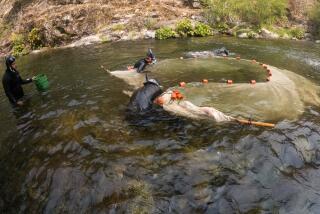Flabby, Farmed Salmon Threaten Their Wild Rivals
- Share via
OSLO — Mass breakouts from Norway’s salmon farms are threatening wild stocks of the prized fish, even though the flabby, farmed variety often can’t leap up waterfalls to spawn.
About a million reared fish escaped on New Year’s Day--the biggest breakout ever--after a hurricane wrecked their pens and gave the salmon a taste of freedom in fiords along the west coast.
Scientists say mixing farmed and wild fish may upset the genetic balance in Norway’s rivers and spread diseases unknown in the wild. To the delight of fishermen, Norway reopened the salmon season near the smashed farms.
Fugitive farmed fish, whose flesh is turned a delicate pink by adding crushed prawn shells or chemicals to their food, already outnumber wild salmon in a few rivers.
Now, two scientists have warned that if more major breakouts occur, they could lead to a total breakdown of the stock structure of the Atlantic salmon in Norway.
Dagfinn Gausen and Vidar Moen, of the Directorate for Nature Management and the Institute for Nature Research, said in a recent report that their findings indicate that “the problem is already far advanced and that it is necessary to take preventive measures now.”
“We feel the only solution is to ensure that escapes do not occur.”
Norway is the world’s biggest producer of farmed Atlantic salmon. During the 1980s, production boomed from 4,000 tons to 160,000 tons.
Soaring output has undermined world prices and pushed many farmers close to bankruptcy. Norway now has a 37,000-ton stockpile of frozen salmon that it is trying to sell. The United States has imposed anti-dumping duties on the fish.
Officials estimate that 2 million Norwegian salmon a year broke out of fish farms in the late 1980s, while between 700,000 and a million wild fish returned to Norwegian rivers every year to spawn.
Farm fish are bred for fast growth and are relatively more docile and less fit than their sleek wild cousins. This is hardly surprising after life in a crowded fish-farm moored in a quiet backwater, eating food pellets and antibiotics rather than struggling in rivers and the depths of the North Atlantic.
Escaped fish have been found with lumps of wood in their stomachs--showing that they have trouble determining what is edible. Others stay near fish farms, unsure where to go.
“But they do learn how to eat fish such as herring and shrimps after a while,” said Roar Lund, a scientist at the Norwegian Institute for Nature Research. “Many survive.”
Escaped farm salmon also mate, crowding the fitter wild fish out of spawning grounds and disturbing evolutionary theory with a “survival of the fattest.”
Among wild salmon, fish in one river are genetically slightly different from those adapted to other rivers. If the pudgy farmed fish mix with wild stocks, these variations could be lost forever and all salmon become a bland hybrid.
Without genetic variation, the species could be more vulnerable to collapse because of a sudden environmental change or epidemic.
The Directorate for Nature Management has set up a sperm bank to preserve genes of salmon from each river.
Norway last year imposed stricter rules on protecting and anchoring pens. But many farms were unable to withstand the New Year’s Day storm, with winds up to 100 knots.
Wild salmon are born in rivers and spend two years or so growing in fresh water before swimming out into the North Atlantic. There they stay until they return to spawn and die in the same stretch of river up to five years later.
Mature farmed fish, having been born in a hatchery, lack the homing instinct and usually go up the first river they come across to spawn.
Surveys show that farm fish often lack the stamina to jump up waterfalls--they also have less power as they wear down each others’ fins by nipping in frustration in crowded pens.
Male farmed fish that make it to the spawning grounds are sometimes too exhausted to compete for females in an aggressive mating ritual in which males fight with sharp teeth. Farmed females seem less careful about where they lay their eggs in the river.
Apart from genetic threats, the farmed fish--based partly on strains from Finland and Iceland--may carry diseases into the wild. Furunkulosis, a disease that destroys muscles, was introduced to Norway by a batch of imported fish.
Henning Rooed of the State Pollution Control Board said fish farmers gave their stock 37.4 tons of antibiotics in 1990--more than the total consumed by Norway’s 4.2 million people.
Hege Johannesen at the Directorate for Nature Management predicted that fish farming will survive despite the problems--fish convert a large amount of what they eat into flesh.
“Compared to farming pigs, for instance, fish farming is cheap and efficient,” she said.
More to Read
Sign up for Essential California
The most important California stories and recommendations in your inbox every morning.
You may occasionally receive promotional content from the Los Angeles Times.













